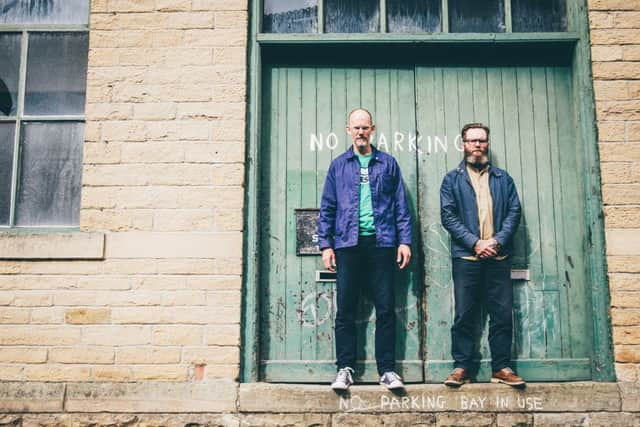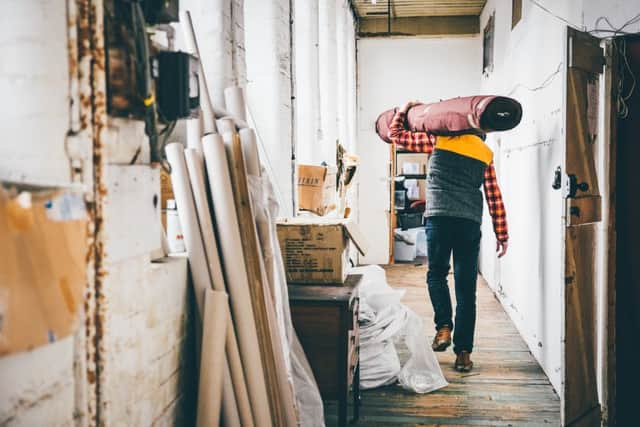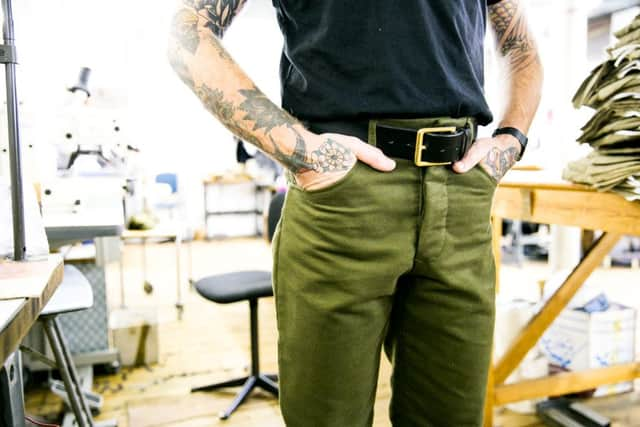Trouser Town legacy has legs in yet


“Our friend Dan has a brewery called Bridestones and he made a beer called Trouser Town. And he said: ‘Yeah, if you look up Hebden Bridge on Wikipedia, one of the first things that comes up is that it used to be called Trouser Town,’ and that stuck.” It sounds like too good a line to be true, coming from a Hebden Bridge start-up making a name for itself selling good-quality, hipster-friendly trousers. But it checks out.
Calder Valley’s fast streams and access to major wool markets meant that, in the 19th and early 20th centuries, Hebden was famous for its clothing manufacture. It used to produce a million pieces per year, around 20,000 per week. HebTroCo is now tapping into that legacy with its moleskin and corduroy trousers.
Advertisement
Hide AdAdvertisement
Hide Ad“It’s your original workwear material,” says Ed Oxley, the other co-founder. “I don’t know if it pre-dates denim, but it’s the British workwear. Here in Hebden everything would have been agricultural, with people living on the hilltops. A tailor would go around the houses and they would make trousers to order. And then, there’s a farm where a woman bought a sewing machine when they were new and started a sewing room and started making to order. And that would have paralleled the growth of a more industrialised population wanting something that was easier to wash than wool, and cheaper, and soft, but had that same hard-wearing quality. So that’s moleskin. That would have been for industrial workers, and corduroy would have been more for agricultural workers’ clothes. And it developed to mass production in east Lancashire and West Yorkshire.”


By the end of 2015, however, the industry had dwindled to just one small factory, with a roundabout history leading back to the Industrial Revolution, now producing less than 200 garments per week.
After discovering Hebden’s legacy, Brant, formerly a mountain bike designer, recruited Ed, who he knew from his work as a bike skills coach and guide. Together they hatched a plan that they hoped would inject some life back into the industry and approached the last remaining factory in Hebden.
“The owner was not interested,” says Ed. “He said: ‘Come back after dinner’ and we went to the pub and came back with a bit of ale swagger. He took us up onto the machine floor, and it’s quite a derelict building. But you go in and there are these seven girls working, making these amazing traditional trousers. The thing that really struck me is the linings inside – like something your grandparents would have worn, when they only had one pair of something and it was made to last.”
Advertisement
Hide AdAdvertisement
Hide AdThe duo came away with two pairs of trousers, bought from a room of dead stock. They can be seen hanging unceremoniously on the wall of the ramshackle room that HebTroCo’s small warehouse occupies in the same old mill as the manufacturer. They’re marked up like a patient heading for plastic surgery, various arrows and circles showing how Ed and Brant wanted their trousers to be retooled for 21st century consumers. The hook and clasp fly went, belt loops were moved, the pockets were changed. Ed and Brant enthuse over a piece of fabric that buttons diagonally behind the fly, a “French bearer”, which adds structure. Fundamentally they’re much like the trousers workers would have worn a century ago.


HebTroCo had its trouser design. The brand launched with a Kickstarter, because “we didn’t have any money,” says Ed. “That’s the big difference between us and Hiut Denim and McNair and all those other, similarly clever-at-marketing companies.
“We’ve had no money from anyone. No grants, no loans, it’s just been... by the seat of our pants,” chuckles Brant. (There’s a steady trickle of trouser puns when you’re talking to HebTroCo.)
Ed and Brant tend to bristle slightly at comparisons to firms such as Hiut or Community Clothing. The backgrounds may be different, but the message is similar – a number of brands are positioning themselves as companies reviving otherwise left-behind clothing traditions, injecting life into local garment manufacturing sectors in places like Blackburn and north Wales.
Advertisement
Hide AdAdvertisement
Hide AdThe Kickstarter campaign was simple compared with the elaborate rewards offered by some projects on the crowd-funding platform. There were no offers of eternal gratitude or gold-coated fly buttons – £95 got you a pair of trousers, dubbed the Founder, in your choice of colour and size. Brant and Ed settled on a Kickstarter goal of 176 pairs, the theoretical output of the factory for one week. They sold out in five hours.


The simplicity of the Kickstarter campaign is reflected throughout HebTroCo’s lean, straightforward approach to business. They sell things you can wear on your legs, and nothing else. There’s no retail space, but you can try on and pick up your trousers from the local bottle shop, Drink. You’ll get a free half-pint if you do, too. Orders are carried down to the local post office on foot to be shipped, because taking a van is too much hassle.
Despite the heritage of the company’s product and its rustic set-up, however, in many ways HebTroCo is emblematic of the modern start-up. Jump-started through crowd-funding, cannily marketed both through its own social media campaigns and digital word of mouth, it’s a business that could exist only in the 21st century.
Still, keeping it local is very much at the heart of what HebTroCo does. “Everything that we do is based, as much as we can, in the valley,” says Ed. “The logo is by a local artist who’s a printmaker and lino cutter, Rachel Red. All the print work is done at Print Bureau in town. Our plastic bags come from Sowerby Bridge...” The list goes on.
Advertisement
Hide AdAdvertisement
Hide Ad“It’s not really about ‘British is best,’” adds Brant. “It’s about working locally with people you like, with people you can go and have a conversation with and bash out any problems. It’s about being able to say: ‘Yes, these are £110 trousers, but here’s why’.”


Through the week, Ed notes, you can go to the factory and find people making a living out of making HebTroCo’s trousers. “We’re online, but from the beginning we thought, how are we going to meet people and connect with people?” he adds. “So we did a pop-up shop in the bike shop Blazing Saddles, who had been flooded. They had an empty unit in the middle of town and we had a bag of trousers, one of each size, and we didn’t have anything else but we had the whole shop to use. So we thought, ‘what are we going to do?’”
The answer was, set up some record decks from the 80s and give away free beer. The event was a hit. “So now we do that,” says Ed. “We go to bars or brewery taps and we’ll do a pop-up to put our names out and do a social event.”
“Why do we want all these different spaces to work in? It’s good for everybody. That was a real thing that came out of the floods here, everyone collaborating. People doing different pop-ups in different spaces. If the internet was one modern way of shopping then collaborating in shared spaces is probably the next way forward,” adds Brant.
Advertisement
Hide AdAdvertisement
Hide AdIt seems to be paying off. “Since we launched last January, we’ve sold 2,000 pairs of trousers,” says Brant. “When I walked into the factory last year they asked: ‘How many do you want?’ and I said: ‘500 a year’. I would say it’s gone a bit crazy.”
The company’s range has expanded to include two belts, a short and the occasional limited-run trouser. Following the success of that initial Kickstarter the temptation was to go large, says Ed. “Immediately we thought, we’ve got to make hats and shoes and jackets and underpants and women’s trousers and everything else,” he adds. “But then we realised no, we need to make the trousers that we’re making better, and keep making them and sell more of them and slow down. We’ve barely done a year yet, and it would be rash to expand too fast and fizzle it out. But we’re planning the next trouser pattern, so the plan is to have another cut that will fit more people and we’re hoping to get that out in the spring.”
Trouser Town’s legacy has some legs in it yet, then.
Photographs: Alex de Palma